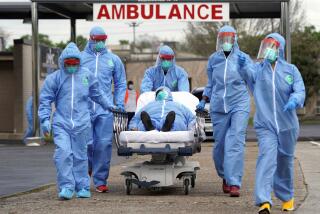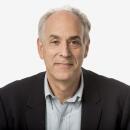Column: What will a possible 240,000 U.S. COVID-19 deaths mean to you? Trump’s projections in perspective

- Share via
Last week, President Trump hosted a somber briefing at the White House where his advisers presented their official COVID-19 death projections. There would likely be between 100,000 and 240,000 Americans dead when the crisis finally abates, said coronavirus task force coordinator Deborah Birx. Without mitigation or social distancing, the fatalities could be much, much higher.
Those numbers represent, as Trump fatuously put it, “a lot of people.” But hearing the numbers is not really the same as understanding them. It’s hard to conceive of what so many deaths will actually mean for a nation of 330 million people if hundreds of thousands — or more — of us were to die. Would it transform us? Destroy us? Or would we put it behind us in a year, a decade or a generation? Has anything like this happened to the United States before?
These days, we’re all studying the maps, the curves, the caseloads, the lethality rates. Stuck at home, glued to the internet, we’re learning the difference between linear scales and logarithmic scales, and trying to make judgments about complex data.
But putting these massive mortality projections into context is difficult. Humans are notoriously unresponsive to statistics; we suffer from what scholars like Paul Slovic of the University of Oregon call “psychic numbing” — both our comprehension and our empathy decline as the death tolls rise.
So here are some facts to help put the projections in comparative perspective.
In 2017, a total of about 2.8 million people died in the United States, according to the Centers for Disease Control and Prevention. The leading cause, as usual, was heart disease, which killed 647,457 people. At a high of 240,000 fatalities (assuming we continue to social distance, and assuming for the moment that the White House estimates are accurate), COVID-19 wouldn’t come close to being the nation’s top killer.
But for comparison’s sake: Alzheimer’s disease killed 121,404 people that year, and in the flu and pneumonia category, 55,672 died. In 2018, about 37,000 Americans died in automobile accidents, according to the National Highway Traffic Safety Administration. So the coronavirus death toll could overtake all of those categories combined.
Another way to think about the coronavirus projections is in historical terms, as Surgeon Gen. Jerome Adams did Sunday when he said that this week would be “Our Pearl Harbor moment, our 9/11 moment.”
Here then are some metrics from U.S. history: In four years, the Civil War killed 750,000 Americans (from a total population of 31 million) and AIDS has killed about 700,000 in the U.S. since 1981.
On the other hand, COVID-19 fatalities are likely to outnumber American deaths in Vietnam (close to 60,000), and dwarf the number who died on 9/11 (nearly 3,000) or at Pearl Harbor (about 2,400).
As you take in the numbers, consider some caveats. For one thing, the number of people who ultimately die of COVID-19 may be far lower or higher than projected; numerous experts have questioned the reliability of the White House estimates.
Besides, the historic significance or emotional toll of such events cannot be conveyed by death tallies alone. Twenty deaths would be unimaginably tragic in a school shooting. Yet in foreign wars and distant natural disasters, we often read of hundreds of thousands of dead, and then turn the page. Sept. 11 was especially traumatizing because of its proximity, because it was an unexpected attack — and because the deaths occurred mostly in a single morning.
Counting the dead sometimes seems like an obsession, and a macabre one at that. In this case, however, there are obvious practical reasons for it. Epidemiologists and biostatisticians track cases and compile predictive models in order to understand where the outbreaks are occurring, which policies are succeeding and how to allocate scarce resources.
But we also count to acknowledge our shared loss, to honor those who died, and because we find it callous and inhumane to let the dead go unnamed or unenumerated. (Carol Tuckwiller, a former librarian, spent six years seeking to identify every Allied soldier killed in the 1944 D-Day attacks.) We also count to give ourselves, as Professor Drew Gilpin Faust, a history professor at Harvard, put it, “an illusion of certitude and control.”
In ”This Republic of Suffering,” her fascinating study of death and the Civil War, Faust described how that conflict brought Americans into day-to-day contact with the horror of death on a mass scale. “Loss became commonplace; death was no longer encountered individually; death’s threat, it’s proximity, and its actuality became the most widely shared of the war’s experiences.“
Will coronavirus do that to us? Will we all know someone who dies — or many people? That’s already happening in New York City, where COVID-19 is especially rampant. The New York Times reported April 2 that “many have already lost someone in their circle — a co-worker, an old friend from high school, the parent of a child’s classmate. The parish priest, the elderly neighbor upstairs. A mother, a father. Almost everyone now knows someone who is sick.”
Perhaps it won’t be that way for Americans living in Montana. But for those from urban areas, especially older people, perhaps it will — depending how successfully we follow the rules of mitigation.
Death tallies and mortality projections are not perhaps the most evocative ways to think about the crisis. Most of us respond more easily to the personal stories of affected people. Numbers can be unsatisfying, even misleading. Perhaps that’s why Walt Whitman (as Faust notes) referred more generally to the “countless graves” and the “infinite dead” of the Civil War.
In fact, they were neither countless nor infinite, but of course, that was his point.
Beginning today, associate editor Nicholas Goldberg will be writing a regular op-ed column for The Times. Goldberg served as The Times’ editorial page editor for 11 years and, before that, was the op-ed and Sunday Opinion editor. He has also worked as a Middle East correspondent and political reporter.
More to Read
A cure for the common opinion
Get thought-provoking perspectives with our weekly newsletter.
You may occasionally receive promotional content from the Los Angeles Times.











